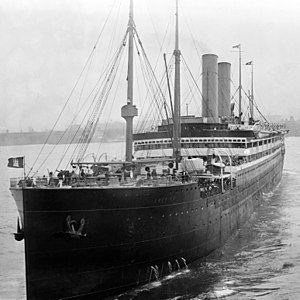
Back Amerika (Schiff, 1905) German SS America (1905) Spanish یواساس آمریکا (آیدی-۳۰۰۶) Persian Amerika (paquebot de 1905) French USS America (ID-3006) ID Amerika (schip, 1905) Dutch
 As Amerika, before the First World War
| |
| History | |
|---|---|
| Name | Amerika |
| Namesake | German spelling of America |
| Owner | Hamburg America Line |
| Builder | Harland & Wolff, Belfast |
| Yard number | 357 |
| Launched | 20 April 1905 |
| Completed | 21 September 1905 |
| In service | 11 October 1905 |
| Out of service | 1 August 1914 |
| Fate | Seized by United States, April 1917 |
| History | |
| Name | USS America (ID-3006) |
| Owner | United States Navy |
| Acquired | 25 July 1917 |
| Commissioned | 6 August 1917 |
| Decommissioned | 26 September 1919 |
| Fate | Transferred to War Department, 26 September 1919 |
| History | |
| Name | USAT America |
| Operator | United States Army |
| Acquired | 26 September 1919 |
| In service | 26 September 1919 |
| Out of service | 1920 |
| Fate | Transferred to the USSB |
| History | |
| Name | SS America |
| Owner | USSB |
| Operator |
|
| In service | 1920 |
| Out of service | 1931 |
| Fate | Transferred to the War Department |
| History | |
| Name | USAT Edmund B. Alexander |
| Namesake | Edmund Brooke Alexander |
| Owner | United States Army |
| Acquired | October 1940 |
| In service | January 1941 |
| Out of service | 26 May 1949 |
| Refit | May 1942 |
| Fate | Scrapped 16 January 1957 |
| General characteristics | |
| Tonnage | 22,622 GRT, 13,637 NRT[1] |
| Length | 669 ft (204 m) |
| Beam | 74.3 ft (22.6 m) |
| Propulsion | 2 steam engines, twin screw propellers |
| Speed | 18 knots (33 km/h; 21 mph) |
| Capacity |
|
| Crew | 577 |
| Differences as USS America: | |
| Displacement | 41,500 Tons |
| Length | 687 ft (209 m) |
| Beam | 75 ft 5 in (22.99 m) |
| Draft | 39 ft 5.25 in (12.0206 m) |
| Speed | 17.5 knots (32 km/h; 20 mph) |
| Complement | 994 |
| Armament |
|
USS America (ID-3006) was a troop transport for the United States Navy in World War I. She was launched in 1905 as Amerika by Harland & Wolff in Belfast for the Hamburg America Line of Germany. As a passenger liner, she sailed primarily between Hamburg and New York. On 14 April 1912, Amerika transmitted a wireless message about icebergs near the same area where RMS Titanic struck one and sank less than three hours later. At the outset of the war, Amerika was docked at Boston; rather than risk seizure by the British Royal Navy, she remained in port for the next three years.
Hours before the American entry into World War I, Amerika was seized and placed under control of the United States Shipping Board (USSB). Later transferred to the U.S. Navy for use as a troop transport, she was initially commissioned as USS Amerika with Naval Registry Identification Number 3006 (ID-3006), but her name was soon Anglicized to America. As America she transported almost 40,000 troops to France. She sank at her mooring in Hoboken in 1918, but was soon raised and reconditioned. After the Armistice, America transported more than 51,000 troops back home from Europe. In 1919, she was handed over to the War Department for use by the United States Army as USAT America, under whose control she remained until 1920.
Returned to the USSB in 1920, America was initially assigned to the United States Mail Steamship Company, and later, after that company's demise, to United States Lines, for which she plied the North Atlantic on Bremen to New York routes. In March 1926, due to an oil leak from inside the ship, near the end of one of her periodic refits, America suffered a fire that raged for seven hours and burned nearly all of her passenger cabins. Despite almost $2,000,000 in damage, the ship was rebuilt and back in service by the following year. In April 1931, America ended her service for the United States Lines and was laid up for almost nine years.
In October 1940, America was reactivated for the U.S. Army and renamed USAT Edmund B. Alexander. After establishing the Newfoundland Base Command and a stint as a barracks ship at St. John's, Newfoundland in January–May 1941, Edmund B. Alexander was refitted for use as a troopship for World War II duty. She was first placed on a New Orleans to Panama route, but later transferred to trooping between New York and European ports. At the end of the war, Edmund B. Alexander was converted to carry military dependents, remaining in that service until 1949. She was placed in reserve until sold for scrapping in January 1957.
- ^ "Trade and Transportation". 27 March 2024.